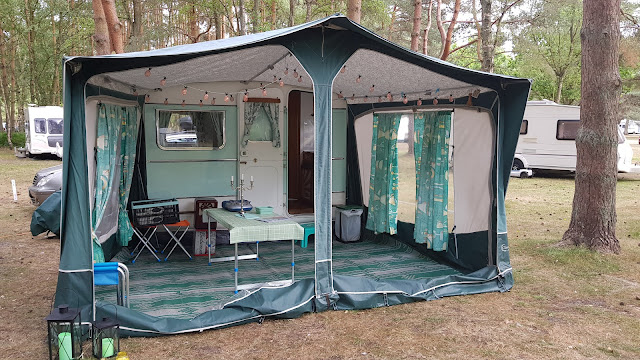Welcome to the story of our caravan renovation.
These photos are of the completed project, having been given a new lease of life and providing us with holidays even though it is more than 50 years old. We hope you will read on over the following 30-odd pages to see how we rebuilt our caravan over a period of four years.
The caravan in question is a 1970 Viking Fibreline (manufactured by Viking Fibreline Caravans), chosen for its curvy styling over the more angular shapes of some other makes. My partner, Lou, fell in love with one belonging to a friend (thank you Tracey, this is all your fault); she found the corner windows particularly endearing, and so nothing else would do. After months of searching, one appeared on ebay and a 'quick' trip to Northampton ensued. We didn’t want a massive project, and this Viking was essentially solid and complete, requiring only a quick makeover – or so we thought!
One week later, we returned to collect the caravan. We knew the skylight was missing so had come prepared with a makeshift cover just to get us home. Typically, it poured with rain whilst fitting it and I got soaked, but at least now we could tow it back to Surrey without any more rain getting in, or windows blowing out due to the air pressure on the motorway. At this point, we had no vehicle access to our back garden so we arranged to store the caravan on a farm and it was on arriving here that we took these pictures. They show the ‘van resplendent in its fetching shades of “hearing aid beige” and “ear wax brown”, delicately applied with a six inch fence brush and a total absence of masking, judging by the state of it. (The tape on the windows was the well-meaning vendor's idea, to prevent the windows from cracking during transit. Do not do this because 1, it is unnecessary, and 2, it takes hours to clean the glue off.)
These photos are of the completed project, having been given a new lease of life and providing us with holidays even though it is more than 50 years old. We hope you will read on over the following 30-odd pages to see how we rebuilt our caravan over a period of four years.
One week later, we returned to collect the caravan. We knew the skylight was missing so had come prepared with a makeshift cover just to get us home. Typically, it poured with rain whilst fitting it and I got soaked, but at least now we could tow it back to Surrey without any more rain getting in, or windows blowing out due to the air pressure on the motorway. At this point, we had no vehicle access to our back garden so we arranged to store the caravan on a farm and it was on arriving here that we took these pictures. They show the ‘van resplendent in its fetching shades of “hearing aid beige” and “ear wax brown”, delicately applied with a six inch fence brush and a total absence of masking, judging by the state of it. (The tape on the windows was the well-meaning vendor's idea, to prevent the windows from cracking during transit. Do not do this because 1, it is unnecessary, and 2, it takes hours to clean the glue off.)

 |
| Hideous seat covers & curtains... |

 |
| ...hiding equally hideous 70's upholstery. |
The history of Viking caravans started in South Africa in the 50's with the Africaravan Gypsey. Their '60s models utilised a one piece roof moulded from glass reinforced plastic (aka GRP, or fibreglass), and a “belly pan” at the bottom from the same material. The vertical walls were aluminium, with novel curved corner windows. The one piece roof meant fewer leaks. Caravans International Ltd acquired Africaravans in 1964 and then a year later, in 1965, the former board of directors from Africaravans created Viking Fibreline Caravans in England. The same design was used by Viking and from their factory in Heads Nook near Carlisle, the first caravans emerged for the 1966 model year. A short introduction in December 1965 and a contemporary review by 'The Caravan' magazine dated June 1966 can be read here. These early versions can be identified by the narrower raised central roof section and the door being nearer the front. By the late sixties, the door had moved rearwards (with a few exceptions, permitted by the hand-built nature of these caravans) and the raised part of the roof became wider allowing more headroom inside. By 1973, the rear corner windows had been discontinued and the front ones were elongated to the same height as the adjacent glass. In 1975, the front corner windows disappeared too, and the front and rear panels changed from aluminium to fibreglass . The last models were produced in 1980. The chassis were supplied mostly by Peak Trailers, though some early models used a chassis from Rubery Owen equipped with a B&B hitch. Click here for more detail in my article on the history of Viking Fibreline Caravans.














